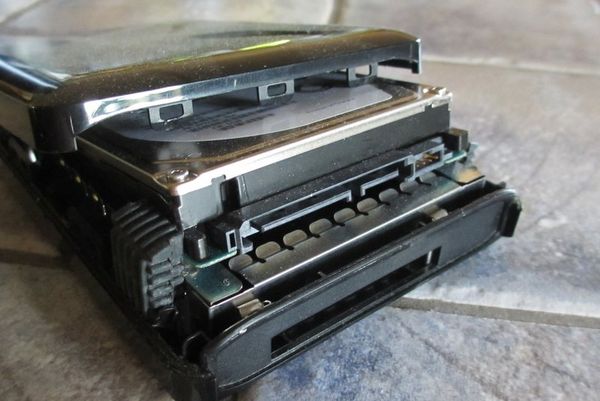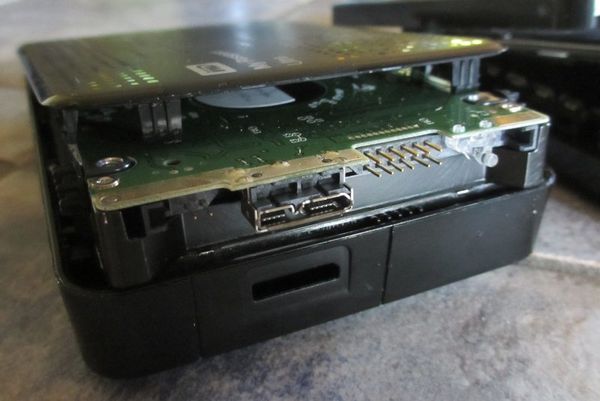Free Agent Aux Drive has stopped showing up - ideas?
May 7, 2015 18:27:25 #
donnahde wrote:
Yes. Seagate's recovery plans start at $499. I thought I'd give the $89 option a try first and that can also be used in the future to test aux hard drives and can also be used on all the computers in our home, too, for testing, repair and recovery. Wish me luck.
Is that all Seagate offered? No answers to any number of different possibilities?
May 7, 2015 19:41:15 #
May 7, 2015 22:33:22 #
donnahde wrote:
Hi Wmontgomery! I was finally able to order the Gibson program you recommended. I've created a CD but have no idea how to use it to try to recover My Seagate Free Agent data. When you have time any advice you can offer to a NON-techie person would be appreciated for sure. Sorry for the lapse since last communication. I've spent a lot of time on their site watching videos and reading the FAQ but must be too stupid to understand how to actually use this. Thanks!
I, too, have used SpinRite for a long time. A quick overview of steps:
1. With the bootable CD you created in your drive you have to boot from the CD. All Windows computers will, during the boot process, respond to specific keystrokes and pop up a menu allowing you to boot off of any bootable device attached to your system. On most HP desktops and laptops pressing the Esc key during the boot process will bring up the menu. Dells historically use F12. As soon as you turn on the machine, start tapping the Esc or F12 key about once per second. If you get to the Windows splash screen you missed it - shutdown and try again. If the menu pops up, select your CD drive to boot from.
2. After SpinRite starts up there will be couple of introductory screens and a straightforward menu where you select the drive partitions you want SpinRite to work with (spacebar is the selector, not Enter). You will also select what level of analysis and repair you want done. You will probably want to go with #2
Possible issues - when you get to the drive/partition selection screen you may not see the external Seagate. This happened to me a couple of times - GRC support told me to change the drive mode in the BIOS from ACHI or RAID to IDE. How? The same Esc or F12 boot menu generally will have an option to go into BIOS setup or configuration mode - navigate through the BIOS configuration menus to Drive type or Drive mode - set it to IDE. Make a note of what it was before you change it.
Boilerplate warning! You can make changes in the BIOS that result in not being able to boot up and many frustrations. Go directly to the change you want to make - save it and get out. Take some comfort in the fact that if things go sideways after making changes, just use the Esc/F12 key during boot to go back into BIOS setup and select the "Reset BIOS to default settings" item.
Non-Boilerplate warning - but just as important! If you have to change drive mode to IDE to run SpinRite MAKE SURE you change it back after SpinRite is done. Windows will not come up (and if it does it may go into recovery mode to try and repair Windows - you DON'T want to go down that rabbit-hole! After having slid down it once I ALWAYS put a yellow sticky in the middle of my screen while SpinRite is running that admonishes "CHANGE IDE to ACHI in BIOS!!!" (my other machine has to be changed back to RAID)
Don't know if you have realized it yet, but SpinRit runs complely outside Windows. Your machine will be tied up for the duration of the run. How long? The absolute fastest is 120G per hour, but you will not see that with a 5200 RPM external USB-connected drive, especially if it has to spend extra time trying to recover bad sectors which is highly likely. When it is running you can use the R/L arrow keys to switch between several monitoring screeens which show elapsed time and anticipated finish time. I have had 2TB drives that took 48 to 72 hours.
HOWEVER, you can stop the process and, on your way out it advises you to note the % completion so you can restart it later and drop right in to the same location on the drive.
This is nice because you can let it run overnight and do your normal computing during the day. IF YOU DO THIS AND HAVE TO SWITCH DRIVE MODES YOU MUST USE THAT YELLOW STICKY NOTE and be switching drive modes before and after running SpinRite!!!
Well -- that turned out to be a not-so-quick overview. :lol: I've tried to balance encouragement with fair warning of possible problem areas.
I know this all can seem intimidating - but you've committed your $89 and I suspect you may have the gumption to dive in.
If you are reluctant I suggest you find a nearby computer person to help you or do it for you.
If you have any questions - please include specifics of your computer and operating system.
May 7, 2015 23:31:06 #
Some operating systems, notably Windows Vista, Windows 7 and Windows 8, do not configure themselves to load the AHCI driver upon boot if the SATA-drive controller was not in AHCI mode at the time of installation. This can cause failure to boot, with an error message, if the SATA controller is later switched to AHCI mode. For this reason, Intel recommends changing the drive controller to AHCI or RAID before installing an operating system. (It may also be necessary to load chipset-specific AHCI or RAID drivers at installation time, for example from a USB flash drive.)
On Windows Vista and Windows 7, this can be fixed by configuring the msahci device driver to start at boot time (rather than on-demand). Setting non-AHCI mode in the BIOS will allow the user to boot Windows, where the required registry change can be performed. The BIOS can then be changed to AHCI.
On Windows 8 and Windows Server 2012, the name of the controller has changed from msahci to storahci, and the procedure to upgrade to the new controller to it is similar to that of Windows 7. On Windows 8 and Windows Server 2012, changing the SATA mode to AHCI without updating the registry will make the boot drive inaccessible.
On Windows Vista and Windows 7, this can be fixed by configuring the msahci device driver to start at boot time (rather than on-demand). Setting non-AHCI mode in the BIOS will allow the user to boot Windows, where the required registry change can be performed. The BIOS can then be changed to AHCI.
On Windows 8 and Windows Server 2012, the name of the controller has changed from msahci to storahci, and the procedure to upgrade to the new controller to it is similar to that of Windows 7. On Windows 8 and Windows Server 2012, changing the SATA mode to AHCI without updating the registry will make the boot drive inaccessible.
May 8, 2015 03:03:36 #
Earworms wrote:
Some operating systems, notably Windows Vista, Win... (show quote)
And just what relevance does cutting and pasting the above unattributed quote from Wikipedia ( http://en.wikipedia.org/wiki/Advanced_Host_Controller_Interface ) have in this discussion? In addition to demonstrating that you have no experience with SpinRite, it introduces completely irrelevant and unnecessary confusion, couched in the techno-jargon the OP has already says is confusing enough.
Like I said in my post above, when you boot off the SpinRite CD Windows has absolutely no involvement in the process - it is not running - it is not active. SpinRite cannot and will not run inside Windows. The SpinRite CD actually boots the FreeDOS operating system which then runs SpinRite. In order for FreeDOS and SpinRite to see all drives attached to the system the drive mode has to be set to IDE in the BIOS. To boot back into Windows the BIOS drive mode MUST be set back to the setting it was changed from (which is, as Wikipedia states, the drive mode Windows was installed under.)
For more details please read first FAQ here: http://www.grc.com/sr/faq.htm and here: http://www.grc.com/sr/kb/sata.htm
May 8, 2015 07:37:44 #
picpiper wrote:
I, too, have used SpinRite for a long time. A quic... (show quote)
Thank you for this detailed help, picpiper. Wrmontgomery has been very helpful as well via private message but is not as familiar with Windows 8.1. I'm using a Dell AIO I7 running Windows 8.1.
I did find, via youtube video search, that if I go to PC Settings-Update & Recovery-Recovery-Advanced Startup-Restart Now-Use a Device.....that I then get a menu including System Restore, System Image Recovery, Startup Repair, Command Prompt, UEFI Firmware Settings, Startup Settings, Enable Boot Logging. I was considering Enable Boot Logging when I got your message about the F12. Which do you think would be best?
Thanks again,
Donna
May 8, 2015 08:39:21 #
FYI....here's a response I got when I asked for help from Spinrite....
GRC Tech Support
To Donna Harding May 7 at 9:37 PM
I'm sure there is a way around that so you can boot to your CD.
Here's a link that may be helpful
<http://www.wikihow.com/Change-BIOS-Mode-from-UEFI-to-Legacy-in-Windows-8>.
Also, some computers come with CSM disabled, which would not let you
change the boot priority TYPE. The boot priority may not be about
the order of which drives to boot from first, but the TYPE of boot,
UEFI vs. Legacy. If you set it to Legacy only, then it should boot
to SpinRite.
More info about UEFI
<http://en.wikipedia.org/wiki/Unified_Extensible_Firmware_Interface>.
Thank you for your cooperation, time and patience.
Sincerely,
Greg McIntyre
Gibson Research
Technical Support
GRC Tech Support
To Donna Harding May 7 at 9:37 PM
I'm sure there is a way around that so you can boot to your CD.
Here's a link that may be helpful
<http://www.wikihow.com/Change-BIOS-Mode-from-UEFI-to-Legacy-in-Windows-8>.
Also, some computers come with CSM disabled, which would not let you
change the boot priority TYPE. The boot priority may not be about
the order of which drives to boot from first, but the TYPE of boot,
UEFI vs. Legacy. If you set it to Legacy only, then it should boot
to SpinRite.
More info about UEFI
<http://en.wikipedia.org/wiki/Unified_Extensible_Firmware_Interface>.
Thank you for your cooperation, time and patience.
Sincerely,
Greg McIntyre
Gibson Research
Technical Support
May 8, 2015 10:53:41 #
I have made a decision to wait to pull the trigger on this until AFTER the wedding I'm shooting on the 16th. I have three proms before then and then the wedding and it makes me excessively nervous that I will do something wrong and have no computer and all these images to deal with and a wedding gallery to create. Thanks for all your help. I will jump back in and let you know when I can more confidently take this step. In the meantime I will be watching for and taking into consideration all reliable advice and keeping a printed file for reference when I am ready. At the moment whatever is on that drive is not as important as the jobs in front of me.
Thanks again!
Donna
Thanks again!
Donna
May 9, 2015 04:17:53 #
donnahde wrote:
Thank you for this detailed help, picpiper. Wrmon... (show quote)
Neither until you do quite a bit more research. Googling "using spinrite on windows 8.1 computers" and "how to boot Windows 8.1 computer from DVD" got me here:
http://www.youtube.com/watch?v=QsBo8yikz7U and here:
http://answers.microsoft.com/en-us/windows/forum/windows8_1-performance/booting-from-my-spinrite-cd-on-windows-81/da7adccd-11e9-40b7-bfa8-3bc60e7d34c2
donnahde wrote:
I have made a decision to wait to pull the trigger... (show quote)
I've been using Windows since 3.0, but I've never used Windows 8 or 8.1. After having done quite a bit more research myself, I think you are very wise to hold off on trying to get SpinRite running on your machine to check out the Seagate drive.
The whole UEFI/Secure Boot/CSM legacy morass that is baked into Windows 8 can be a real nightmare. Each manufacturer seems to have a different take on how and whether you can boot off CD/DVD/USB sticks. You should not attempt it until you find explicit instructions about how to boot off the CD/DVD for your specific Dell model.
There are several online videos and instructions that may get you to a CD boot session. I want you to be sure you understand how to get back into a Boot Manager session to resume normal Windows 8.1 boots after a SpinRite session. I've not come across an answer to that. I came across references that Dell uses the Del key during power up to get into BIOS or Boot Manager. Don't know if that is the case on a UEFI machine.
Since you have some time, I strongly urge you to post a question about booting from CD and resetting to boot back into Windows 8.1 over on the Dell support forums - probably in the disk-drives area:
http://en.community.dell.com/support-forums/disk-drives/
donnahde wrote:
Question from non-techie me: HOW can SpinRite fix a drive it can't see? Once I get my head wrapped around that I'll definitely be investing in this nifty product. Oh also, would I be able to use for mine AND my s/o's computers? We both have Dell AIO's.
Thanks!
Thanks!
One last point. I jumped in on this topic after you indicated you had purchased SpinRite and I did not fully appreciate the complexity of CD boots on a Windows 8/8.1 machine. Had I seen your "...fix a drive it can't see?" question before you bought SpinRite this would have been my answer:
Good point - if your drive is spinning and you've swapped out cables, tried different ports and different computers it is either a bad drive or the electronics in the enclosure have failed. The quickest and easiest way to check out the drive is to open up the enclosure, take out the drive and either use a docking station:
http://www.amazon.com/gp/product/B005UA3I72/ref=s9_simh_gw_p147_d0_i3?pf_rd_m=ATVPDKIKX0DER&pf_rd_s=desktop-1&pf_rd_r=040J5YZ4SK2VR6YY2XQG&pf_rd_t=36701&pf_rd_p=2079475242&pf_rd_i=desktop OR a new drive enclosure:
http://www.amazon.com/StarTech-com-3-5in-SuperSpeed-Drive-Enclosure/dp/B003F5NS9W/ref=sr_1_2?s=electronics&ie=UTF8&qid=1431131143&sr=1-2&keywords=drive+enclosure+startech
to find out if the drive is truly dead.
There's a 50/50 chance the drive is fine. Check out this links:
http://discussions.apple.com/docs/DOC-6121
By the way, some of the newer drives going into external cases have a circuit board attached to the drive and don't have standard connectors. They cannot be used in docking stations or standard SATA drive enclosures. I discovered that when I opened up WD Passport Ultra with the intent of putting it into an aluminum enclosure.
One other last point - All hard drives die, some die suddenly when they are young or old, and some just gradually start losing sectors. I maintain a personal fleet of about 18 drives - internal and external, in desktops, laptops and a NAS storage server. I have to deal with drive issues at least a couple of times a year. This after spending a 30 year career supporting hundreds of PCs and servers. Drive failures are just one of the facts of digital life.
Standard SATA connectors Seagate GoFlex 1.5TB

Non-standard connector - WD Passport Ultra - won't go into standard enclosure

May 9, 2015 09:22:03 #
picpiper wrote:
One last point. I jumped in on this topic after yo... (show quote)
Wow, picpiper. Thank you so very much for all this vital info. There is a 30 day refund on the spinrite. I think I'll take advantage of that and buy it again when I have a professional willing to take this on for me. Or maybe that pro will already own it. (-: I'm cutting and pasting all this advice into a Word document that will serve me when I'm ready. Thanks again for all your time, picpiper and wrmontgomery as well. Whatever is on that Free Agent drive can stay there for a while.
If you want to reply, then register here. Registration is free and your account is created instantly, so you can post right away.



